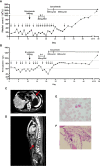Case Report: Prompt Response to Savolitinib in a Case of Advanced Gastric Cancer With Bone Marrow Invasion and MET Abnormalities
- PMID: 35444940
- PMCID: PMC9013970
- DOI: 10.3389/fonc.2022.868654
Case Report: Prompt Response to Savolitinib in a Case of Advanced Gastric Cancer With Bone Marrow Invasion and MET Abnormalities
Abstract
Gastric cancer is one of the most common malignant tumors and patients show a short survival, those combined with bone marrow invasion have a median survival of only 37 days. Here we reported the treatment of a 47-year-old male with advanced gastric cancer and complicated with bone marrow invasion and extensive metastases, who did not tolerate chemotherapy, under monotherapy with savolitinib, a MET receptor tyrosine kinase inhibitor. Before treatment, the patient was in severe pain and presented with thrombocytopenia and hemorrhagic anemia. Savolitinib was given based on amplification and rearrangement of the MET gene in his tumor. After savolitinib treatment, the patient's condition promptly improved, efficacy evaluation indicated partial remission, and the patient was alive and remained progression-free at 15 weeks at the time of reporting. No obvious adverse reactions occurred. Besides, another case of a female gastric cancer patient with MET amplification who received savolitinib monotherapy as a third-line treatment that remained progression-free at 12 weeks was also reported. This report provides a new reference for understanding MET abnormalities in gastric cancer and offers a possibility for future application of MET tyrosine kinase inhibitors in the therapy of gastric cancer with MET abnormalities. Also, it suggests that sequencing of MET can be considered a routine target in advanced gastric cancer patients.
Keywords: MET gene; advanced gastric cancer; bone marrow invasion; case report; savolitinib.
Copyright © 2022 Ye, He, Su, Zheng, Ding and Ye.
Conflict of interest statement
The authors declare that the research was conducted in the absence of any commercial or financial relationships that could be construed as a potential conflict of interest.
Figures



Similar articles
-
Savolitinib: A Promising Targeting Agent for Cancer.Cancers (Basel). 2023 Sep 25;15(19):4708. doi: 10.3390/cancers15194708. Cancers (Basel). 2023. PMID: 37835402 Free PMC article. Review.
-
Significant role of savolitinib in a case of advanced gastric cancer with abnormal mesenchymal-epithelial transition factor (MET): A case report.Medicine (Baltimore). 2022 Dec 2;101(48):e32072. doi: 10.1097/MD.0000000000032072. Medicine (Baltimore). 2022. PMID: 36482562 Free PMC article.
-
Osimertinib plus savolitinib in patients with EGFR mutation-positive, MET-amplified, non-small-cell lung cancer after progression on EGFR tyrosine kinase inhibitors: interim results from a multicentre, open-label, phase 1b study.Lancet Oncol. 2020 Mar;21(3):373-386. doi: 10.1016/S1470-2045(19)30785-5. Epub 2020 Feb 3. Lancet Oncol. 2020. PMID: 32027846 Clinical Trial.
-
Prominent response to savolitinib monotherapy in high-grade fetal adenocarcinoma with MET amplification and concurrent brain metastasis: a case report.Transl Lung Cancer Res. 2024 Jun 30;13(6):1407-1413. doi: 10.21037/tlcr-24-124. Epub 2024 Jun 25. Transl Lung Cancer Res. 2024. PMID: 38973955 Free PMC article.
-
Response and acquired resistance to savolitinib in a patient with pulmonary sarcomatoid carcinoma harboring MET exon 14 skipping mutation: a case report.Onco Targets Ther. 2019 Sep 6;12:7323-7328. doi: 10.2147/OTT.S210365. eCollection 2019. Onco Targets Ther. 2019. PMID: 31564914 Free PMC article. Review.
Cited by
-
FDP/FIB ratio serves as a novel biomarker for diagnosing bone marrow invasion in gastric cancer and predicting patient prognosis\.Sci Rep. 2025 Mar 19;15(1):9462. doi: 10.1038/s41598-025-93056-8. Sci Rep. 2025. PMID: 40108276 Free PMC article.
-
Dramatic response and acquired resistance to savolitinib in advanced intrahepatic cholangiocarcinoma with MET amplification: a case report and literature review.Front Oncol. 2023 Nov 2;13:1254026. doi: 10.3389/fonc.2023.1254026. eCollection 2023. Front Oncol. 2023. PMID: 38023194 Free PMC article.
-
Gastric cancer patient with MET amplification treated with crizotinib achieves long-term survival: a case report.AME Case Rep. 2024 Dec 4;9:27. doi: 10.21037/acr-24-118. eCollection 2025. AME Case Rep. 2024. PMID: 39866270 Free PMC article.
-
Savolitinib: A Promising Targeting Agent for Cancer.Cancers (Basel). 2023 Sep 25;15(19):4708. doi: 10.3390/cancers15194708. Cancers (Basel). 2023. PMID: 37835402 Free PMC article. Review.
References
Publication types
LinkOut - more resources
Full Text Sources
Miscellaneous

